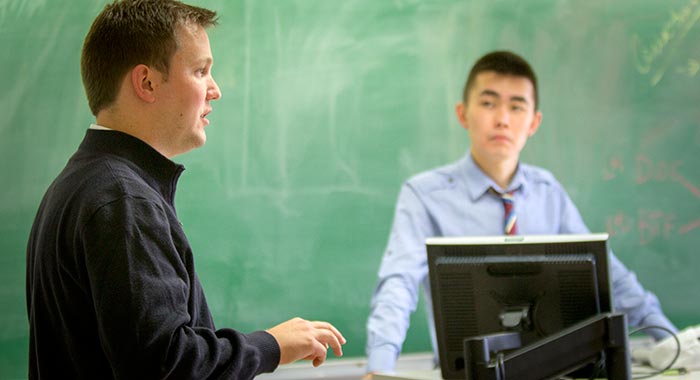Alumni Experience Steers Classroom Business Simulation
A major hurricane shrinks demand for your product in the South.
A competitor takes over your market in the Northeast, forcing you to shut down operations there and explain it to your board of directors.
These are nightmares for those in the business world, but thankfully only a fictitious exercise for students in introductory management classes taught by Jamie O’Brien (Business Administration).
O’Brien is partnering with Breakthrough Fuel, a Green Bay-based supply chain fuel management company populated with St. Norbert alumni, to provide students with real-world exercises that supplement academic theory.
“My goal is to increase the frequency with which students get exposed to practical issues,” O’Brien says. “In the real world, we don’t always deal with problems that have an easy answer. We have to be able to think on our feet.”
After determining their fictitious business’ product line, students track movements in the supply chain and create business presentations using tools such as Microsoft Excel and PowerPoint. They draw a “shock” event, such as the hurricane scenario, from a hat at various points during the semester, and that’s when the business adventure really begins.
“These ‘shocks’ can affect product demand and delivery in very different ways,” O’Brien says. “It throws a wrench into the works and really challenges the students’ problem-solving abilities.”
Business partnership offers mutual benefits
O’Brien initially contacted Breakthrough Fuel employee Yerzhan Nauruzbayev ’13 to explore possibilities for collaboration. The discussion made its way through the organization to Peter Romenesko ’10. The Breakthrough Fuel team presented the project plan to the class and was very clear about its objectives.
“Not only were we rolling out the project, we were defining why all the work would be requested of them,” Romenesko explains. “These aren’t just mindless tasks, and we felt obligated to explain that to them. One thing I was surprised about was how well the students responded to that, and how quickly they started answering other students’ questions. It was pretty cool.”
Breakthrough Fuel sees its involvement in the class as paying it forward, with an eye toward networking with tomorrow’s business leaders. The company’s client list includes major names such as Procter & Gamble; Whirlpool; Unilever; and Andersen Windows and Doors.
“The benefit for us is introducing new ideas to the future employees of a big company somewhere,” Romenesko says. “When the time comes in budget season and their commodity cost goes up, maybe they’ll think about energy and give us a call. What we’re doing is introducing a new idea, and educating them about how to bring in energy as a savings once they get into the marketplace.
“We really appreciated the opportunity to participate. The energy and transportation worlds are very fast-paced. This allows students to slow down and talk about a concept, and lay it as a foundation. It teaches them how to think about things differently.”
Long-term benefits for students
O’Brien would like to involve the Breakthrough Fuel team in the grading process, inviting real-life feedback on projects generated from real-world situations.
“The students might not get this same level of interaction at a bigger school, and it’s important for them to use this interaction as positively as they can,” O’Brien says. “It would be a nice talking point in a job interview. They’re going into a tough market, and they need to differentiate themselves somehow.”
Nov. 5, 2013












